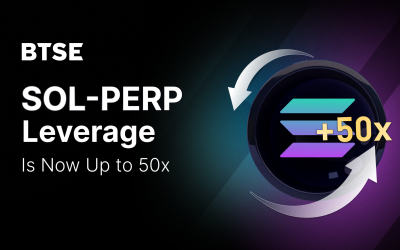Top Stories
BTSE Lists Zebec Network (ZBCN); 1 Million ZBCN Airdrop
We’re thrilled to welcome Zebec Network (ZBCN) to the BTSE family! Zebec is a decentralized infrastructure network for real-world value flows. To...
Decreasing Max Leverage for ApeCoin Perpetual Futures (APE-PERP) to 20x
Starting on April 24, 14:00 (UTC +8), the max leverage allowed for trading ApeCoin Perpetual Futures (APE-PERP) will be decreased from 50x to 20x. ...
Increasing Max Leverage for Solana Perpetual Futures (SOL-PERP) to 50x
Starting on April 24, 16:00 (UTC +8), the max leverage allowed for trading Solana Perpetual Futures (SOL-PERP) will be increased from 20x to 50x. ...
BTSE Will List Propy (PRO) on April 17, 2024
BTSE will list Propy (PRO) token on April 17, 2024, making it available for spot trading. Additionally, PRO will be listed on BTSE’s wider ecosystem...
The Bitcoin Halving is Coming! Trade Bitcoin and Selected Tokens to Win a Share of Our 6.5 BTC Prize Pool!
The fourth Bitcoin halving is upon us, set to take place on April 20. To celebrate this important and historic event, BTSE is launching the Bitcoin...
BTSE Will List Zeus Network (ZEUS) on April 16, 2024
BTSE will list the Zeus Network (ZEUS) token on April 18, 2024, making it available for spot trading. Additionally, Zeus will be listed on BTSE’s...
Important Update: Upcoming Token Delistings and Changes to Services on BTSE
Dear BTSE Users, As part of our ongoing commitment to maintaining the highest quality standards across our range of assets and services, we...
Exploring the Post-Halving Price Predictions for Bitcoin: Expert Edition
The Bitcoin community is on the edge of its seat as the next halving event draws near. Scheduled for April 2024, this event is anticipated to...
Unleashing the WMINIMA Trading Blitz: Trade & Get a Chance to Split $15,000 in WMINIMA Tokens!
A new event is taking the community by storm! Join BTSE's WMINIMA Trading Blitz, boasting a hefty prize pool of $15,000 worth of WMINIMA tokens....
Stay Informed with BTSE
Join Our Newsletter
Never miss a beat with the latest updates and industry insights.
Follow Us
Join our rapidly growing community and exclusive events!









